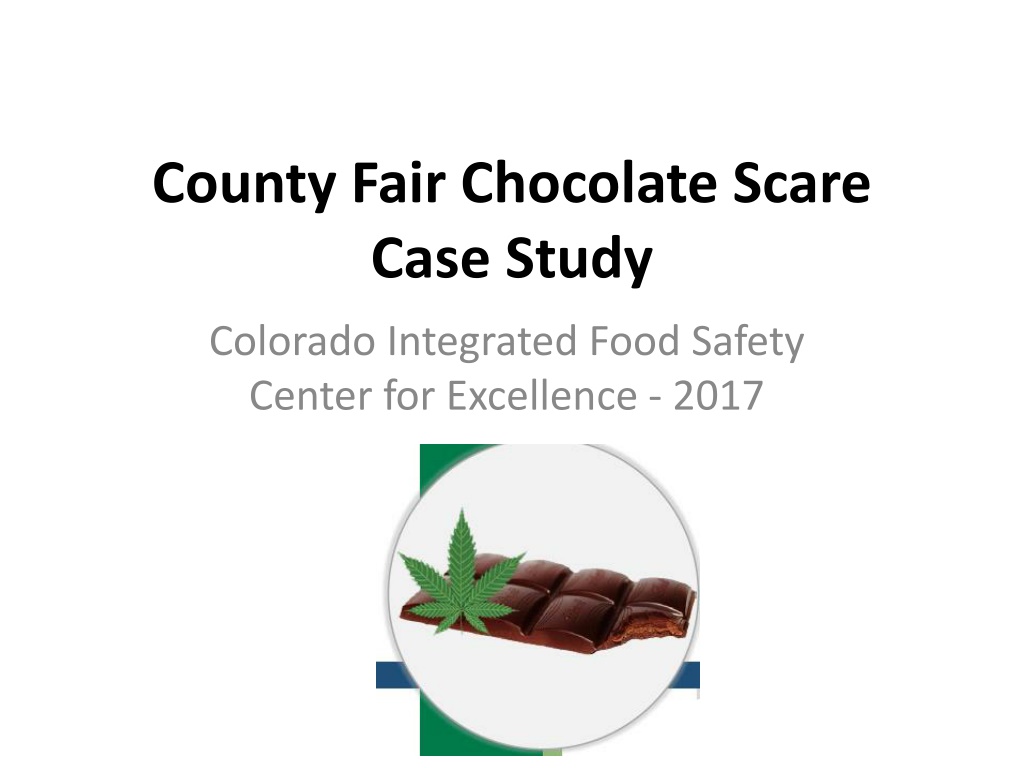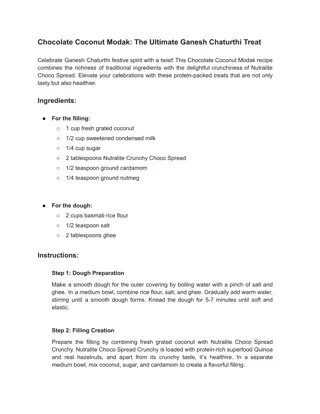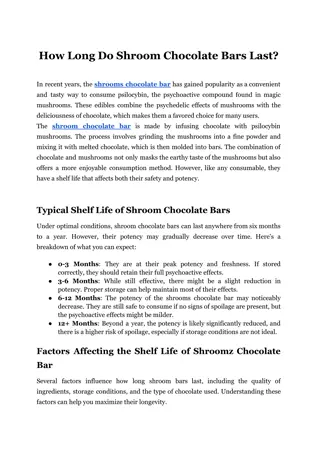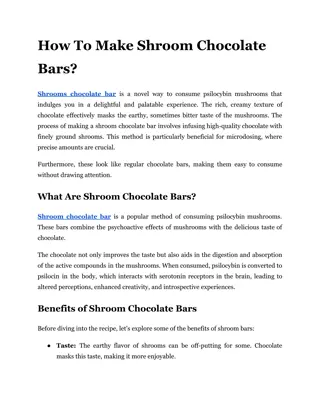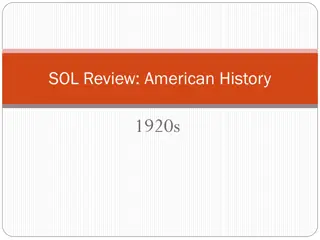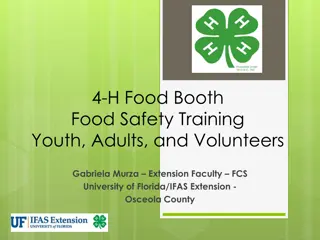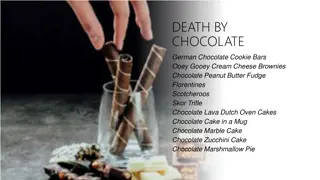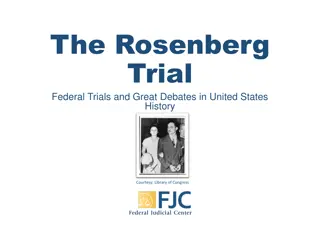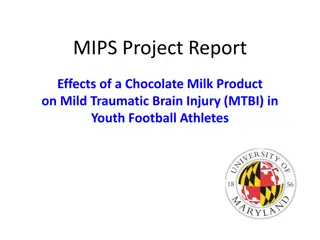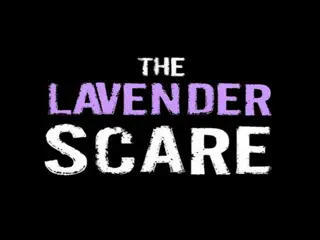County Fair Chocolate Scare Case Study - Colorado Integrated Food Safety Center for Excellence
Based in Denver, Colorado, this case study discusses a foodborne illness outbreak at a county fair due to unintentional marijuana-infused food consumption. The study aims to prompt discussions among health professionals on responding to such outbreaks, outlining objectives like identifying unintentional marijuana exposure and formulating investigation questions. The scenario involves an attendee experiencing symptoms after consuming a chocolate bar at the fair's Pot Pavilion, leading to an investigation into the incident. Recommendations for preventing future incidents are also highlighted.
Download Presentation

Please find below an Image/Link to download the presentation.
The content on the website is provided AS IS for your information and personal use only. It may not be sold, licensed, or shared on other websites without obtaining consent from the author. Download presentation by click this link. If you encounter any issues during the download, it is possible that the publisher has removed the file from their server.
E N D
Presentation Transcript
County Fair Chocolate Scare Case Study Colorado Integrated Food Safety Center for Excellence - 2017
County Fair Chocolate Scare Case Denver, Colorado Summary: the case study is based on a foodborne illness outbreak caused by the unintentional ingestion of marijuana-infused foods (edibles) at a county fair in Colorado. Case study designed to facilitate a discussion among disease investigators, epidemiologists, medical staff and other public health professionals about how to respond to an outbreak involving a marijuana-infused food.
Objectives After completing this case study, participants should be able to: Give an example of an unintentional marijuana exposure Name agencies that may be involved in an unintentional marijuana exposure investigation List available resources that address marijuana exposure Formulate interview questions for an unintentional marijuana exposure investigation.
Objectives (cont.) Establish a case definition for marijuana exposure. List special considerations that should be made during an environmental assessment of a marijuana facility. Recommend control measures to prevent unintentional marijuana exposure in the future.
Denver County Fair Dates: Weekend of: August 1 August 3 Attendees: ~ 20,000 people Featured: Themed vendor pavilions highlighting selected businesses The Pot Pavilion For 21 years and older Housed 44 vendors Vendors were ONLY allowed to talk Vendors could NOT display, sell or consume any marijuana or infused products. Products were defined as: marijuana flower (bud, grass), concentrates (hash oil, shatter), and infused foods and drinks.
Initial Complaint Call came in on Tuesday August 5thto Public Health Male attended fair on Sunday August 3 Symptoms: anxious and weird Tightness of chest, heavy head & body, dry mouth and intense nausea Symptoms began one hour after consumption of chocolate bar (LoveALL booth @ Pot Pavilion) Consumed only of bar due to an off taste Wife did not consume bar and felt fine Recovered by next day
Also Complained to the Vendor The man called the vendor to assure him that the chocolate bar did not contain marijuana Wanted to document the official complaint since started new job the next week New job required drug test
Question #1 Question 1: What other agencies might you involve or consult after receiving this initial complaint? PLEASE WRITE DOWN RESOURCE IDEA(S) ON POST-IT NOTE
Complaint #2 On Monday, August 4th Denver Public Health contacted the Marijuana Enforcement Division (MED) Colorado Department of Revenue MED received a similar complaint from a man reporting nausea, loss of coordination, and dizziness after consuming samples from a vendor at the Pot Pavilion The man reported using marijuana in the past and stated the chocolate bars got him high previously had NOT experienced nausea or disorientation from marijuana use.
More Complaints MED contacted the Denver County Fair coordinator, Four individuals reporting symptoms after attending the Pot Pavilion. The coordinator provided contact information for the additional persons. The MED, with the Denver Police Department, had already launched a criminal investigation. PH was left to determine whether to initiate a PH investigation PH contact Environmental Health (who inspect marijuana facilities) to discuss the situation.
Question #2 Question 2: Would you investigate this incident further as a foodborne outbreak?
The Investigation Begins After consulting with the State Health Department and the Centers for Disease Control and Prevention (CDC) considers unintentional ingestion of a marijuana- infused food a reportable foodborne illness, Denver PH and EH decided to initiate an outbreak investigation to determine the source of contamination
Question #3 Question 3: What resources would you use to find additional information on marijuana- infused foods? PLEASE WRITE DOWN RESOURCE IDEA(S) ON POST-IT NOTE
Question #3 Question 3: What resources would you use to find additional information on marijuana-infused foods? California Bureau of Cannabis Control http://bcc.ca.gov/ California Poison Control System (UCSF/SFGH) https://calpoison.org CDPH Center for Environmental Health Division of Food, Drug and Cannabis Safety https://www.cdph.ca.gov/Programs/CEH/DFDCS/Pages/DF DCS.aspx
CDPH Division of Food, Drug & Cannabis Safety
Marijuana / THC 101 Tetrahydrocannabinol (THC) is the primary active ingredient in marijuana-infused foods (edibles). In Colorado, the maximum serving size for retail, marijuana- infused foods is 10mg of active THC single serving sizes must be clearly marked. A retail product cannot contain more than 100mg THC total.
Common Effects of Marijuana anxiety, panic, or paranoia increased heart rate increased blood pressure decreased interest in normal activities increased appetite dry mouth red eyes Include: a happy, relaxed, or high feeling slower reactions and hand/eye coordination distorted perceptions of time and distance difficulty thinking, learning, and remembering
Symptoms of Overconsumption Include: extreme confusion, anxiety, panic, or paranoia hallucinations or delusions increased blood pressure severe nausea and vomiting psychosis suicidal ideations
Marijuana Consumption Marijuana is eaten, effects typically take longer to start (up to 4 hours) and last longer (4-10 hours) than smoked or inhaled marijuana. Marijuana-infused foods are absorbed by: gastrointestinal uptake (digested through the stomach), oral uptake (digested through saliva), or a hybrid of gastrointestinal and oral uptake. Time to onset and duration of effects depend on method of absorption, dose, and individual factors, such as prior marijuana use.
Absorption of Marijuana-Infused Foods Time to onset and duration of effects depend on method of absorption, dose, and individual factors, such as prior marijuana use.
Question #4 Question 4: What questions would you ask during these initial case interviews? PLEASE WRITE DOWN QUESTION(S) ON POST-IT NOTE
Public Health Line List On August 3rd, all four cases reporting consuming samples at the LoveAll booth in the Pot Pavilion
How to Create a Case Definition Question #5 Person Place Time Clinical Features
How to Create a Case Definition Question #5 Person (age, sex, race, occupation, etc.) Place (specific geographic location or facility) Time (period of time associated with illness onset for cases under investigation) Clinical Features (signs, symptoms and laboratory tests)
How to Create a Case Definition Question 5: Based on the information provided so far, establish a case definition for this outbreak
Case Definition (Working) Anyone who attended the Pot Pavilion at the Denver County Fair on August 3rd; AND Subsequently had two or more of the following symptoms: nausea, vomiting, disorientation, dizziness, anxiety, hallucinations, stomach ache, dry mouth, numbness/tingling in extremities, confusion, dyspnea, sweating, fainting, chest tightness, loss of coordination, panic, paranoia, difficulty in speaking, or memory loss.
Question #6 Question 6: How would you find additional cases? Any ideas for enhanced reporting and surveillance PLEASE WRITE DOWN IDEA(S) ON POST-IT NOTE
Question #6 Question 6: How would you find additional cases? Ask cases know other individuals who attended the event and became ill Contact local hospitals, ER, and urgent cares Contact other local jurisdictions for similar complaints Ask vendors if they received any complaints Ask vendors if they collected contact information on patrons Ask fair coordinator for list of patrons Media
Situation Status Update On August 12th, a health department in a nearby county notified Denver Public Health of 5 additional cases three adults two children Denver Police Department reported one additional case to Denver Public Health on August 14th NEW total case count: 10 cases.
Epidemiologic Studies Question # 7
Common Epidemiology Study Foodborne Illness Outbreaks COHORT Well-defined group of individuals - Members are easily identifiable - Members are easily accessible Exposure is rare There may be multiple diseases involved CASE-CONTROL Disease or outcome of interest is rare, or The group is not well-defined - Identifying entire cohort would be too costly or time consuming - Accessing entire cohort would be too costly or time consuming Preferred Study Design When Measure of Association Study compares the incidence of disease in exposed persons and unexposed persons Relative Risk (RR) Study compare the odds of exposure between the ill (cases) and the not ill (contacts) Odds Ratio (OR)
Common Epidemiology Study Foodborne Illness Outbreaks COHORT CASE-CONTROL Study population is grouped by exposure status Study population grouped by outcome Study Group Exposed persons Persons with illness (cases) Comparison Group Unexposed persons Persons without illness (controls) Examples Determine if the coleslaw was the cause of a foodborne outbreak Determine an association between salmonella infection and eating at a fast food restaurant
Question #7 Question 7: What type of epidemiologic study would you conduct to investigate this outbreak?
Question #7 Question 7: What type of epidemiologic study would you conduct to investigate this outbreak? Both Study Designs Work Here BUT Case-Control would be the BEST Compare fairgoers with illness (cases) to Sample of fairgoers without the illness (controls)
Measure of Association Assess the strength of an association between an exposure and the outcome of interest Indicate how more or less likely one is to develop disease as compared to another Two widely used measures: Relative Risk (RR, or risk ratio) Odds Ratio (OR)
Measure of Association Relative Risk (Cohort Study) The risk of disease in the exposed group divide by the risk of disease in the non-exposed group Odds Ratio (Case-Control Study) The risk of disease cannot be directly calculated because the population at risk is not known
Interpretation of Measures Both the RR and the OR are interpreted as follows: =1 - indicates no association >1 - indicates a positive association <1 - indicates a negative association
Interpretation of Measures If the RR = 5 People who were exposed are 5X more likely to have the outcome then compared with persons who were not exposed If the RR = 0.5 People who were exposed are half as likely to have the outcome then compared with persons who were not exposed If the RR = 1 People who were exposed are no more or less likely to have the outcome then compared with persons who were not exposed
Tests of Significance Indication of reliability of the association that was observed Answers the question: How likely is it that the observed association may be due to chance? Two main tests: 95% Confidence Intervals (CI) p-values
95% Confidence Interval (CI) The 95% CI is the range of values of the measure of association (RR or OR) that has a 95% chance of containing the true RR or OR One is 95% confident that the true measure of association falls within this interval
Interpreting 95% Confidence Interval (CI) To have a significant association between exposure and outcome, the 95% CI should not include 1.0 A 95% CI range below 1 suggest less risk of the outcome in the exposed population A 95% CI range above 1 suggests a higher risk of the outcome in the exposed population
Environmental Assessment Environmental assessment is to conduct a systematic, detailed, science-based evaluation of environmental factors that contributed to the transmission of illness in an outbreak.
Question #8 Question 8: What special considerations should be made during an environmental assessment of a marijuana facility? PLEASE WRITE DOWN CONSIDERATION (S) ON POST-IT NOTE
Environmental Assessment 101 An assessment should include: interviewing workers and managers, sampling, making observations, reviewing records, identifying contributing factors and environmental antecedents, and implementing control measures
Joint Facility Investigation EH was joined by MED as a criminal investigation was ongoing during the assessment Employees could not be interviewed by EH staff because of ongoing criminal investigation.
Outbreak Conclusion MED and Police Department reviewed video of surveillance of the facility from July 29 to August 3rd No post-production tampering or comingling of THC and non-THC chocolates Police Department did not share findings with PH
Question #9 Question 9: Discuss control measures and future recommendations to prevent unintentional ingestion of marijuana-infused foods. PLEASE WRITE DOWN CONTROL MEASURE (S) ON POST-IT NOTE
Discussion IMPORTANT NOTE: People assume that a product infused with marijuana would give off an odor or flavor similar to marijuana. However, as demonstrated by this investigation, this was not the case The initial complaint case only stated the product has an off-taste and no cases reported an odor
